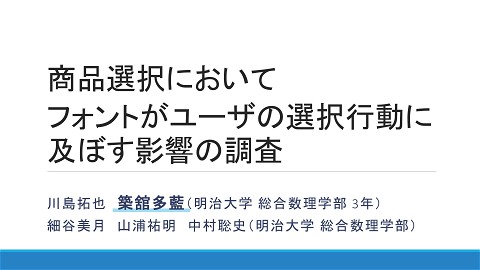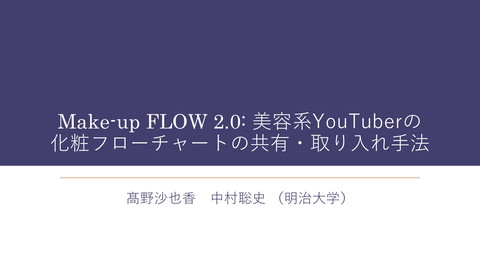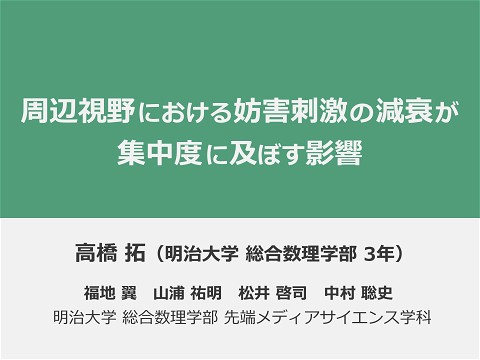reco.mu: A Music Recommendation System Depending on Listerner’s Preference by Creating a Branching Playlist
319 Views
November 03, 21
スライド概要
ICEC2021で使用した発表スライド
明治大学 総合数理学部 先端メディアサイエンス学科 中村聡史研究室
関連スライド
各ページのテキスト
reco.mu: A Music Recommendation System Depending on Listener’s Preference by Creating a Branching Playlist Kosuke Nonaka, Satoshi Nakamura Meiji University, Tokyo, Japan
Overview We proposed a recommendation method that can efficiently attract people's attention and make them feel attractive by using playlist with branching structure. 1st music 2nd music … reco.mu https://reco.mu
Overview We implemented a prototype music recommendation system called “reco.mu” and operated this in practice. 1st music 2nd music … reco.mu https://reco.mu
Overview : demo We can create branching playlist easily with this system. reco.mu https://reco.mu
Overview : demo We can listen to music with diverging according to evaluation. reco.mu https://reco.mu
Overview : demo Most of the contents are in Japanese, but some of the songs are in English, so please try them out if you like. reco.mu https://reco.mu
Background The development of music streaming services has led to a rapid increase in music in circulation. For example… Apple Music provides 70 million pieces of music. Spotify provides 50 million pieces of music. (as of October 1, 2021, in Japan)
Background The development of music streaming services has led to a rapid increase in music in circulation. For example… Apple Music provides 70 million pieces of music. Spotify provides 50 million pieces of music. (as of October 1, 2021, in Japan) People can find popular and well-known music easily.
Background Music that is not well-known is difficult to find. No matter how good the music is, if it doesn't get noticed, it won't even be appreciated. Artists may not earn sufficient income due to name recognition bias.
Background Music that is not well-known is difficult to find. Artists may find it difficult to continue their work. Their fans will lose a chance to listen to their new music.
Background We may be able to know about such music through recommendation systems or word of mouth. However It is difficult to truly understand the appeal of such music by simply looking at • recommendations with little metadata and low accuracy, • or word of mouth with a small population.
Background We need to establish a recommendation method that can easily attract people's attention and make them feel attractive.
Background We focus on the fans of such artists. They may increase new fans by actively recommending music to others and drawing them into the artist or genre. Fans
Background People familiar with specific music have already accumulated knowledge about that music. We expected that they may have willing to recommend their favorite content to others. Fans Recommending considering knowledge level and preferences
Background Would you like to listen to this song? I love this one! I'd like you to try this next... Fans
Background Changing recommending content makes it possible to Would you like listen to this song? present more suited totothe individual’s preferences. I love this one! This may improve recommendation satisfaction. I'd like you to try this next... Fans
Background It is not realistic to speak directly to all users in real-time for recommending. It is not easy to store and use such real-world conversation logs for recommender systems. Fans
Proposed method We propose a method that represents interactive conversation like a flowchart and creates a playlist with a branching structure to make recommendations. Like Not like Not having branching structure Fans 1st music 2nd music … Listener
Proposed method People familiar with a particular artist or genre creates a branching playlist. Like Not like Not having branching structure Fans 1st music 2nd music … Listener
Proposed method The listener responds to the recommended music by liking it or not liking it. Like Not like Not having branching structure Fans 1st music 2nd music … Listener
Proposed method The method proceeds to suggest the next piece of music accordingly. Like Not like Not having branching structure Fans 1st music 2nd music … Listener
Proposed method • Our proposed method will provide listeners with many opportunities to encounter new music. • The listeners will more find it attractively. Like Not like Not having branching structure Fans 1st music 2nd music … Listener
Proposed method We think our proposed methods can make listeners more find it attractive than non branching playlist. Like Not like Not having branching structure Fans 1st music 2nd music … Listener
reco.mu : Implementation reco.mu https://reco.mu
reco.mu : Design of branching playlist We focus on the conversation between a recommender and a listener. Fans Listener The recommendation strategy could be classified into several categories depending on how people recommend. Anyway, I want you to listen to the most famous song first! I have two patterns of recommend for you...
reco.mu : Design of branching playlist We prepared 8 shapes for recommendation considering how people recommend.
reco.mu : Design of branching playlist Some people might make recommendations so that they check the preferences of the other each time. Others may want you to listen to all the songs they want to recommend.
reco.mu : Example One user selected song by Queen as first song for playlist of 80’s rock music. The users create playlists according to their own recommendation strategies.
Result We analyzed the operational results for about six months. (from July 19, 2020, to January 13, 2021) Number of created playlists Number of playbacks for all playlists branching 52 5407 non-branching 32 2967
Result : visualization of playback Like Not like Not having branching structure The thickness of the arrows indicates the number of times played. The thicker the pink arrow, the more listeners evaluated as favorite and played it.
Result : visualization of playback More listeners rated the first music as their favorite. The subsequent pink branches also tend to be evaluated as favorite. Like Not like Not having branching structure This indicates that the listener traced the playback in the way the creator intended.
Result : visualization of playback The arrows for the first two music are thicker, but the latter half is thinner. This suggests that this playlist may not have sufficiently attracted the listener.
Result : visualization of playback The listener behavior changes depending on the strategy and intention of the playlist creator.
Result : playback rate Number of playback We calculated the average percentage of listeners who played playlist up to a certain point. 126 116 105 94 87 78 We defined this playback rate as Number of playback in No. n song Number of playback in 1st song We compared this indicator for branching and non branching playlist. Playback rate 126 116 105 94 87 78 126 126 126 126 126 126
Result : playback rate The percentages of the number of people who played each playlist to the end are ( • about 40% for branching playlist • about 20% for non branching playlist 30 branching playlists and 17 non branching playlists, excluding those we could not play due to system malfunction )
Result : playback rate The values are higher for branching playlist at any points. This result suggests that users may find more interested by using branching playlists for playback.
Result : playback rate We asked recommenders how they created a playlist from free text. We received responses of 36 branching playlists and 24 non branching playlists.
Result : questionnaire survey branching non-branching We can see some answers that considering the recommendation target. There were many answers that people created without considering the order. Some people said that it was fun to make because of its strategic nature. They created playlist with emphasizing their favorite songs. Ex. Ex. It was fun to think about the branching structure. I placed in order of appearance in the search. I listed them in the order I thought of them.
Result : questionnaire survey non-branching branching We can see some answers that considering the recommendation target. There were many answers that people created without considering the order. Some people said that it was fun to make because of its strategic nature. They created playlist with emphasizing their favorite songs. There is a difference in the way the playlist is created depending on whether branching or not.
Result : questionnaire survey branching non-branching We can see some answers that considering the recommendation target . There were many answers that people created without considering the order. Some people said that it was fun to make because of its strategic nature. They created playlist with emphasizing their favorite songs. Considering the recommendation target is more important than emphasizing their favorite songs for recommendation.
Result : playback rate (by type of responses) Playlists for all analysis Playback Rate Playlists considered listener preferences Playlists emphasized the recommenders’ favorite music Music position in playlist
Result : playback rate (by type of responses) branching > Playback Rate Playlists considered listener preferences Playlists emphasized the recommenders’ favorite music Music position in playlist
Result : playback rate (by type of responses) branching > Playback Rate Playlists considered listener preferences Playlists emphasized the recommenders’ favorite music This result suggests that it is essential to be aware of the person to whom they are recommending. Music position in playlist
Result : playback rate (by type of responses) non-branching > Playback Rate Playlists considered listener preferences Playlists emphasized the recommenders’ favorite music Music position in playlist
Result : playback rate (by type of responses) non-branching All 6 answers were to the effect that Playlists considered listeners preferences 1st music “I first chose music that is popular with everyone then gradually chose lesser-known music.” 2nd music … more maniacal 1st music 2nd music … more maniacal
Result : playback rate (by type of responses) non-branching In non branching playlist, the probability of not liking a next maniacal song is higher than in a branching playlist because the next music is fixed even if the listener evaluates. 1st music 2nd music … Maybe you like one of them? 1st music 2nd music … This song always plays.
Result : playback rate (by type of responses) non-branching In non branching playlist, the probability of not liking a next maniacal song is higher than in a branching playlist because the next music is fixed even if the listener evaluates. This gap in preference and familiarity between the recommender and listener may have caused many listeners to discontinue playback.
Result : playback rate (by type of responses) non-branching branching Playback rate Number of Pieces considered the listener 20 /36 > emphasized one’s favorite considered the listener 8 /36 The use of branching playlists makes it possible 6 /24 < emphasized one’s favorite 14 /24 to be more aware of the recommendation target and to make recommendations that are more interesting to the listener.
Challenges / Future work Branching playlist is more burdensome to create than non branching. 1.08 0.38 This method does not allow us to get the other's response immediately. People might feel burdened because they do not have the pleasure of interacting with others.
Challenges / Future work 1st music 2nd music … It would be possible to reduce the burden of creation by having multiple people working on it. In order to test this hypothesis, we are planning to conduct an experiment to compare the case of a single person creating and the case of two people creating.
Challenges / Future work If you want to recommend a cooking video, You can attracrt the userʼs attention more by preparing two videos that will be played next depending on the rating.
Challenges / Future work This user-generated continuum of data may also be used as metadata for other recommendation systems. Using as meta data Recommendation systems
Summary Proposed method Representing interactive conversation like a flowchart and creating a playlist with a branching structure to make recommendations. We also implemented prototype system “reco.mu” and operated it in practice. Result The use of branching playlists makes it possible to be more aware of the recommendation target and to make recommendations that are more interesting to the listener.





